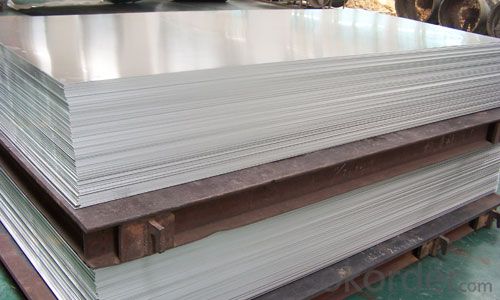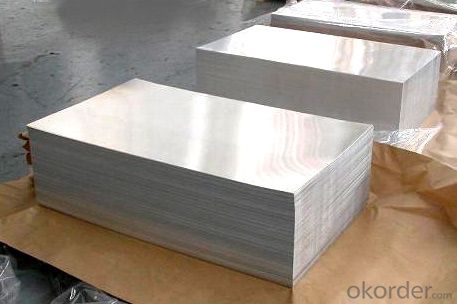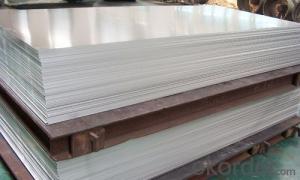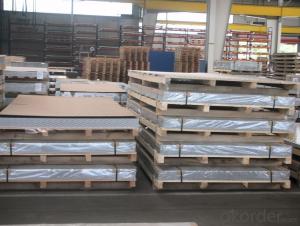Plain aluminium sheet with competitive price
- Loading Port:
- Shanghai
- Payment Terms:
- TT or LC
- Min Order Qty:
- 5 m.t.
- Supply Capability:
- 9000 m.t./month
OKorder Service Pledge
OKorder Financial Service
You Might Also Like
Item specifice
Aluminum sheet specifications:
1) Alloy : 1050 1060 1070 1100 2024 3003 3004 3105 3A21 5005 5052 5083 5754 5182 5454 5456 6061 6063 7075 8011 etc
2) Temper: O/H12/H14/H1/H18/H32/H34/H36/H38//H111/H112/H116/H321/T6/T651/T3/T351 etc
3) Thickness: 0.1mm to 300mm
4) Width:20mm to 3300mm
5)Length: ≤ 12000mm
6) Protective film can be added
7) Production Line: DC and CC production line

alulminium sheet
Features:
1.Superior quality of raw material.
2.Reasonable and stable chemical composition.
3.Accurate tolerance.
4.Goode mechanical property.
5.We have the certificate of ISO9001.
6.Our quality is based on EN,ASTM,JIS.
7.We provide free sample service.
8.The products can be made according to your requirement.
9.Sincerely welcome your inquiry.

5000 series Aluminum coil :
a common choice for automobile manufacturing industry(car side door, mould, sealing parts) and tank making industry etc.
Specifications:colorful aluminium foil for medicine bottle caps
1.alloy 8011 h14
2.thickness 0.17-0.21mm
3.used aluminium vial seals
Packing: 80~100kgs per coil or as your requirement and use strong wooden box or pallet
Delivery Time: 25~35days after order and deposit
Payment: 30% T/T in advance, 70% balance payment against copy of B/L
Shipping:transportation by sea ,Ning Bo and Shang Hai port.

- Q:I need to fix some connections at my dad's house. The original wiring is aluminum, but the newer stuff he did is copper. Simple wire nuts will not suffice. Already had one melted one. I need to fix the connections, but need an economical, safe way of doing it. Suggestions?
- The wire on the exit signs are silver in color but are probably not aluminum, usually having some content of nickel causing the silver appearance. But I can't see the wire over the internet, but if you really think they are aluminum you need to find connectors that are labelled cu/al that have a special antioxidant contained in the connector. If they aren't aluminum the special connectors won't hurt a thing.
- Q:How do you prevent scratches during transportation of aluminum sheets?
- To prevent scratches during transportation of aluminum sheets, there are several measures that can be taken: 1. Proper packaging: Ensure that the aluminum sheets are packaged securely in appropriate materials such as bubble wrap, foam, or cardboard to provide cushioning and protection from external impacts. 2. Use protective layers: Place protective layers such as paper or plastic film between individual sheets to prevent direct contact and minimize chances of scratching. 3. Secure stacking: When loading aluminum sheets onto transportation vehicles, ensure they are stacked securely to prevent any movement or shifting during transit. This can be achieved by using appropriate strapping or palletizing techniques. 4. Handling with care: Train personnel involved in the transportation process to handle the aluminum sheets with care, avoiding dragging or sliding them against rough surfaces that may cause scratches. 5. Avoid contact with sharp objects: Make sure that the aluminum sheets are not in contact with sharp objects or edges that may cause scratches. This can be achieved by keeping them away from other materials or using protective covers. 6. Regular inspection: Regularly inspect the aluminum sheets during transportation to identify any potential scratches or damages. If any are found, immediate action should be taken to prevent further damage. By following these preventive measures, the chances of scratches occurring during the transportation of aluminum sheets can be significantly reduced, ensuring that the sheets are delivered in optimal condition to their destination.
- Q:What are the physical properties of aluminum?
- Aluminum is a lightweight and malleable metal with a silver-white appearance. It has a relatively low melting point of 660.3 degrees Celsius (1220.5 degrees Fahrenheit) and a boiling point of 2519 degrees Celsius (4566 degrees Fahrenheit). Aluminum has a density of 2.7 grams per cubic centimeter, making it about one-third the density of steel. It is a good conductor of electricity and heat, making it widely used in electrical transmission lines and heat sinks. Aluminum is also resistant to corrosion due to the formation of a thin, protective oxide layer on its surface. This property makes it suitable for various applications in industries such as construction, automotive, aerospace, and packaging.
- Q:Are the aluminum sheets recyclable?
- Yes, aluminum sheets are highly recyclable. Aluminum is one of the most recyclable materials on the planet, and it can be recycled indefinitely without losing its quality. Recycling aluminum sheets requires less energy compared to producing new aluminum from raw materials, which has significant environmental benefits. The recycling process involves melting down the aluminum sheets to extract the metal, which can then be used to produce new aluminum products. Recycling aluminum sheets not only conserves valuable resources but also helps reduce greenhouse gas emissions and landfill waste. Therefore, it is highly recommended to recycle aluminum sheets whenever possible.
- Q:or aluminum ? and what other gases are released?
- Aluminium does not normally react with water because of a surface coating of the highly unreactive Al2O3 that forms on exposure to atmospheric oxygen. In the presence of strong base, however, this compound dissolves due to complexation by hydroxide, similarly to how silver chloride dissolves in ammonia. Al2O3(s) + 2OH-(aq) + 3H2O(l) ----- 2[Al(OH)4]-(aq) Once this has occured, aluminium metal, a very strong reducing agent, is exposed to water. 2Al(s) + 6H+(aq) ----- 2Al3+(aq) + 3H2(g) Even though the solution is alkaline, there is still a low concentration of H+ formed by the autoprotolytic dissociation of water. The Al3+ formed then reacts with hydroxide to produce more [Al(OH)4]-. Yes, the hydrogen gas is from the water.
- Q:How do you prevent oxidation of aluminum sheets?
- To avoid oxidation of aluminum sheets, several techniques can be utilized. One commonly used method is to apply a protective coating or finish on the surface of the aluminum sheets. This coating acts as a barrier between the aluminum and the external environment, preventing the metal from reacting with oxygen and forming an oxide layer. There are various types of coatings available for this purpose, such as anodizing, painting, and powder coating. Anodizing involves creating a controlled oxide layer on the aluminum surface through electrolysis. This oxide layer is highly resistant to corrosion and provides excellent protection against oxidation. Painting and powder coating, on the other hand, involve applying a layer of paint or powdered polymer to the aluminum surface. These coatings create a physical barrier that shields the metal from oxygen and moisture. Another effective approach to prevent oxidation is by using aluminum alloys that have enhanced corrosion resistance. These alloys are specifically designed to have a higher resistance to oxidation and can withstand exposure to harsh environments without forming a significant oxide layer. In addition to coatings and alloy selection, proper storage and handling practices play a crucial role in preventing oxidation. It is important to store aluminum sheets in a clean, dry, and well-ventilated area to minimize exposure to moisture and corrosive elements. Contact with acidic or alkaline substances should be avoided, as they can accelerate the oxidation process. Regular cleaning and maintenance of aluminum sheets also help prevent oxidation by removing any contaminants that could promote corrosion. In summary, preventing oxidation of aluminum sheets involves a combination of protective coatings, appropriate alloy selection, and proper storage and handling practices. By implementing these measures, the lifespan and durability of aluminum sheets can be significantly improved.
- Q:What is the typical thermal expansion coefficient of aluminum sheets?
- The typical thermal expansion coefficient of aluminum sheets is around 23.1 x 10^-6 per degree Celsius. This means that for every degree Celsius increase in temperature, the length of an aluminum sheet will increase by approximately 23.1 millionths of its original length. It is important to note that this value can vary slightly depending on the specific alloy and processing conditions of the aluminum sheet.
- Q:I have no idea, and I can't figure this out, and neither can my aunt and she's super smart. It's this project that's due on Monday, and if I can't get it turned in, then I get detention and a failing lab grade. The only information I have is it's $2.96 for a roll of aluminum, it contains 2.96 square meters, and it weighs .995 grams...
- say it's a trick question, because it there is no denotational value for a single aluminum atom :/
- Q:Can aluminum sheets be used for pharmaceutical cleanrooms?
- Indeed, pharmaceutical cleanrooms can make effective use of aluminum sheets. Aluminum, known for its exceptional qualities, is a widely employed material in cleanroom construction. Its lightweight nature, durability, and resistance to corrosion make it ideal for establishing and maintaining a hygienic and uncontaminated environment. Within the cleanroom, aluminum sheets can serve various purposes including wall and ceiling panels, as well as other surfaces. These sheets are easy to clean and sanitize, guaranteeing a contamination-free pharmaceutical cleanroom. Furthermore, aluminum's non-porous nature prevents the growth of harmful bacteria and fungi. Consequently, aluminum sheets present a fitting choice for the construction of pharmaceutical cleanrooms.
- Q:What is the typical bend radius for aluminum sheets?
- The typical bend radius for aluminum sheets can vary depending on the thickness of the sheet and the specific alloy being used. However, in general, a typical bend radius for aluminum sheets ranges from 0.8 to 2 times the thickness of the sheet.
1. Manufacturer Overview |
|
|---|---|
| Location | |
| Year Established | |
| Annual Output Value | |
| Main Markets | |
| Company Certifications | |
2. Manufacturer Certificates |
|
|---|---|
| a) Certification Name | |
| Range | |
| Reference | |
| Validity Period | |
3. Manufacturer Capability |
|
|---|---|
| a)Trade Capacity | |
| Nearest Port | |
| Export Percentage | |
| No.of Employees in Trade Department | |
| Language Spoken: | |
| b)Factory Information | |
| Factory Size: | |
| No. of Production Lines | |
| Contract Manufacturing | |
| Product Price Range | |
Send your message to us
Plain aluminium sheet with competitive price
- Loading Port:
- Shanghai
- Payment Terms:
- TT or LC
- Min Order Qty:
- 5 m.t.
- Supply Capability:
- 9000 m.t./month
OKorder Service Pledge
OKorder Financial Service
Similar products
New products
Hot products
Related keywords





























